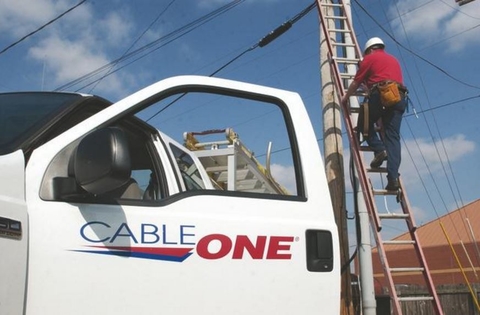Cable One Misses Q2 Broadband Targets as More Fixed Wireless Competition Looms
Rural operator adds 1,300 residential broadband subscribers, faces stiff competition from FWA, Moffett says

Cable One reported Q2 results on Thursday, missing analysts’ consensus targets for broadband subscriber growth, as one influential analyst believes its problems may only be beginning.
Cable One added 1,300 residential broadband customers in Q2, soundly missing analysts’ consensus estimates of 5,200 additions. While some analysts wrote off the miss as part of the overall decline in broadband growth the rest of the industry is experiencing -- the top three publicly traded cable operators either reported flat or negative broadband customer growth in Q2 -- MoffettNathanson senior analyst Craig Moffett feared it could be a sign of stiffer competition from fixed wireless access providers.
Cable One, like the rest of the cable industry, has seen its stock price slip this year. As of Thursday (August 4), Cable One shares were down about 18% for the year to $1,441.80 each. On Friday (August 5), the stock slipped another 5% to $1,368.19 per share in early trading.
Also: Analyst Says Telcos Better Positioned to Chip Away at Cable's Broadband Lead
But even through that difficulty, Cable One has enjoyed one of the strongest trading multiples in the cable business. Cable One stock was trading at a 37% premium to Charter Communications on August 4 -- mainly because its largely rural footprint was free from serious fiber broadband competition and its relatively low market penetrations meant it had a long runway for growth. In a research note on August 4, Moffett noted that those days may be over as fixed wireless offerings take hold.
“Fixed wireless has found its greatest success in rural markets, where the market is underserved and price sensitive, and when carriers tend to have excess capacity,” Moffett wrote. “Cable One’s broadband growth has slowed along with everyone else’s, and they may now arguably face more competition than peers, at least from FWA.”
NEXT TV NEWSLETTER
The smarter way to stay on top of the streaming and OTT industry. Sign up below.
Fixed wireless growth has been strong in Q2, with T-Mobile adding 560,000 FWA customers in the period, well above analysts expectations, and Verizon adding about 256,000 FWA subscribers. T-Mobile overlaps between 40% and 50% of Cable One’s footprint, according to Wells Fargo Securities media analyst Steven Cahall, but the company said it hasn’t seen much of an increase in FWA competition so far.
In a conference call with analysts Thursday, Cable One CEO Julie Laulis said that T-Mobile hasn’t had much of an impact on Cable One, adding that it appears that most of T-Mobile’s additions in Cable One’s footprint are former telco digital subscriber line customers. Verizon’s impact, she said, has been “virtually nothing.”
“Overlap does not take into account network quality/capacity, which we think accounts for the difference here,” Cahall wrote in a note to clients. “[Cable One] has also segmented its customer base with higher speed offerings, which we think further insulates the threat.”
Also: Cable's Broadband Slowdown Hasn't Hit Bottom Yet, Analyst Says
Moffett stressed that he wasn’t criticizing Cable One management or its business, but merely pointing out that the hefty premium its stock price has enjoyed over the years may not be entirely justified.
“What we are struggling with is stock selection within a cable sector that we believe is oversold and underappreciated,” Moffett wrote. “As much as we admire Cable One, we struggle to see why such a large premium – indeed, any premium – is warranted here. We believe there are better opportunities to be had elsewhere in the group.”
The analyst also worried that without a wireless play to fall back on, the outlook could be even bleaker. Wireless has been the biggest growth engine for Comcast and Charter as broadband growth has declined.
“Is any premium at all justified if Cable One’s growth prospects are no better – and arguably, without wireless, worse – than Charter’s?” Moffett asked.
Adding to the pressure is Cable One’s relatively high prices for broadband -- its $80.44 residential ARPU is 23% higher than Charter’s. Although its ARPU can be a bit misleading -- it has extremely low penetration of video, meaning that those remaining generally pay for much more expensive tiers of service, which helps boost the number -- Moffett noted that Cable One customers also tend to pay for higher speeds of broadband which are more costly. That could mean that Cable One has extracted most of the benefit from the video/broadband mix that lies ahead than its cable peers, he said.
That, Moffett wrote, could be enough to send growth metrics southward. He added that with a predominantly rural footprint with customers that have the least disposable income in MoffettNathanson’s coverage universe, Cable One is more vulnerable to price competition. While that had little effect when competitors couldn’t justify building out their networks to its markets, lower cost FWA makes it a whole new ballgame.
“As a percentage of disposable income, Cable One’s prices are the highest in the industry. This could make them more vulnerable to competitive price-based offers and to macroeconomic weakness,” Moffett wrote. ■
Mike Farrell is senior content producer, finance for Multichannel News/B+C, covering finance, operations and M&A at cable operators and networks across the industry. He joined Multichannel News in September 1998 and has written about major deals and top players in the business ever since. He also writes the On The Money blog, offering deeper dives into a wide variety of topics including, retransmission consent, regional sports networks,and streaming video. In 2015 he won the Jesse H. Neal Award for Best Profile, an in-depth look at the Syfy Network’s Sharknado franchise and its impact on the industry.

